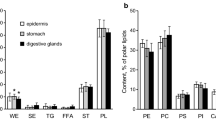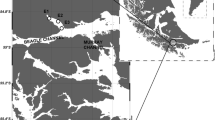Abstract
Tetracosapolyenoic fatty acids (TPA), namely tetracosapentaenoic (24:5n-6) and tetracosahexaenoic (24:6n-3) acids, are chemotaxonomic biomarkers of octocorals (Cnidaria, Octocorallia) in the marine environment. The present study confirms the occurrence of TPA on a marine non-cnidarian taxon, the nudibranch mollusc Armina maculata. This discovery is explained by the specialized feeding regime (stenophagy) of this sea slug that preys upon the octocoral Veretillum cynomorium. The prevalence of 24:5n-6 and 24:6n-3 in the body of A. maculata was demonstrated through the analysis of specimens starved for 30 days in captivity. Since the time frame is superior to the residence time of ingested octocorals, the present findings provide empirical evidence that the reported TPA are allocated from nudibranch tissues. Here we found support for previous claims that the presence of TPA in the marine tree of life is not restricted to its lower branches, as stenophagous trophic interactions may allow its transfer to or posterior biosynthesis in more evolved taxa.
Similar content being viewed by others
References
Arts M, Brett M, Kainz M (2009) Lipids in aquatic ecosystems. Springer, New York, 377 p
Baptista M, Lopes VM, Pimentel MS, Bandarra N, Narciso L, Marques A, Rosa R (2012) Temporal fatty acid dynamics of the octocoral Veretillum cynomorium. Comp Biochem Phys B 161:178–187
Baretta-Bekker H, Duursma E, Kuipers B (2012) Encyclopedia of marine sciences. Springer Science & Business Media, Heidelberg, 349 p
Calado R, Leal MC (2015) Trophic ecology of benthic marine invertebrates with bi-phasic life cycles: What are we still missing? Adv Mar Biol 71:1–70
Cimino G, Ghiselin MT (1999) Chemical defense and evolutionary trends in biosynthetic capacity among dorid nudibranchs (Mollusca: Gastropoda: Opisthobranchia). Chemoecology 9:187–207
Dembitsky VM, Rezanka T, Kashin AG (1993) Fatty-acid and phospholipid composition of freshwater mollusks Anadonta piscinalis and Limnaea fragilis from the river volga. Comp Biochem Phys B 105:597–601
Faulkner D, Ghiselin M (1983) Chemical defense and evolutionary ecology of dorid nudibranchs and some other opisthobranch gastropods. Mar Ecol-Progr Ser 13:295–301
Figueiredo C, Baptista M, Rosa I, Lopes AR, Dionisio G, Rocha RJM, Cruz IGC, Kikuchi RKP, Simões N, Leal MC, Tojeira I, Bandarra N, Calado R, Rosa R (2017) 3D chemoecology and chemotaxonomy of corals using fatty acid biomarkers: latitude, longitude and depth. Biochem Syst Ecol 70:35–42
Fontana A, Tramice A, Cutignano A, D’Ippolito G, Gavagnin M, Cimino G (2003) Terpene biosynthesis in the nudibranch Doriopsilla areolata. J Org Chem 68:2405–2409
Gavagnin M, Mollo E, Castelluccio F, Ghiselin MT, Calado G, Cimino G (2001) Can molluscs biosynthesize typical sponge metabolites? The case of the nudibranch Doriopsilla areolata. Tetrahedron 57:8913–8916
Guerriero A, Ambrosio MD, Pietra F, Chimica I, Trento U (1990) Isolation of the cembranoid preverecynarmin alongside some briaranes, the verecynarmins, from both the nudibranch mollusc Armina rnaculata and the octocoral Veretillum cynomorium of the East Pyrenean Mediterranean Sea. Helv Chim Acta 73:277–283
Imbs AB (2016) High level of tetracosapolyenoic fatty acids in the cold-water mollusk Tochuina tetraquetra is a result of the nudibranch feeding on soft corals. Polar Biol 39:1511–1514
Latyshev NA, Naumenko NV, Svetashev VI, Latypov YY (1991) Fatty acids of reef-building corals. Mar Ecol-Progr Ser 76:295–301
Putz A, Königa GM, Wägele K (2010) Defensive strategies of Cladobranchia (Gastropoda, Opisthobranchia). Nat Prod Rep 27:1386–1402
Svetashev VI, Vysotskii MV (1998) Fatty acids of Heliopora coerulea and chemotaxonomic significance of tetracosapolyenoic acids in coelenterates. Comp Biochem Phys B 119:73–75
Vysotskii MV, Svetashev VI (1991) Identification, isolation and characterization of tetracosapolyenoic acids in lipids of marine coelenterates. Biochim Biophys Acta 1083:161–165
Urban MC (2015) Accelerating extinction risk from climate change. Science 348:571–573
Acknowledgments
This study was funded by the Portuguese Foundation for Science and Technology (FCT) through the strategic project UID/MAR/04292/2013 granted to MARE, doctoral grant to CS, AL, MB and ES, post-doctoral grant of TR and IR and Investigador FCT Consolidation Grant to RR.
Author information
Authors and Affiliations
Corresponding author
Rights and permissions
About this article
Cite this article
Rosa, R., Santos, C., Lopes, A. et al. Stenophagy as a Pathway for the Occurrence of Unique Coral Fatty Acid Biomarkers in Higher Branches of the Marine Tree of Life: The Nudibranch Armina maculata Case. Ocean Sci. J. 54, 297–305 (2019). https://doi.org/10.1007/s12601-019-0004-z
Received:
Revised:
Accepted:
Published:
Issue Date:
DOI: https://doi.org/10.1007/s12601-019-0004-z




